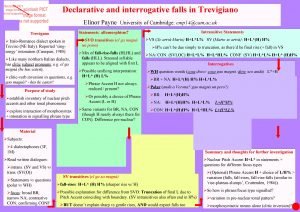Declarative and interrogative falls in Trevigiano Elinor Payne

- Slides: 1

Declarative and interrogative falls in Trevigiano Elinor Payne University of Cambridge: emp 14@cam. ac. uk Intransitive Statements: allomorphism? Trevigano Ø Italo-Romance dialect spoken in Treviso (NE Italy). Reported ‘singsongy’ intonation (Canepari, 1980) ØLike many northern Italian dialects, has clitic subject pronouns, e. g. el ga magnà (he has eaten); Øclitic-verb inversion in questions, e. g. gao magnà? - has he eaten? Purpose of study Øestablish inventory of nuclear pitch accents and other tonal phenomena Øexplore interaction of morphosyntax + intonation in signalling phrase type SVO transitives (el ga magnà un pomo) ØMix of fall-rise-falls (HLHL) and falls (HLL). Stressed syllable appears to be aligned with first L ØPossible unifying interpretation: H+L* (H) L% ØPhrase Accent H not always realised / present? ØOr possibly a choice of Phrase Accent (L or H) ØSame variants for BR, NA, CON (though H nearly always there for CON). Difference pre-nuclear? ØVS (Xe arivà Mario) H+L*L% SV (Mario xe arivà): H+L*(H) H% ØH% can’t be due simply to truncation, as there’d be final rise (+ fall) in VS ØNA/ CON: (SVLOC) H+L*L% H+L*HL% CONF: (SV) H+L*L% H+L* (H)H% Interrogatives ØWH question words (cosa diseo/ cosa gao magnà /dove xeo andà) L*+H ØBR + NA: H+L*(H) H% H+L*L% ØPolar (andà a Verona? /gao magnà un pero? ) ØBR: H+L*(H)H% ØNA: H+L*(H)H% H+L*L% L+H*H% ØCON: H+L*(H)H% H+L*HL% L+H*LL% Material ØSubjects: Ø 4 dialectophones (3 F, 1 M) Summary and thoughts for further investigation ØRead written dialogues: Øintrans. (SV and VS) vs trans. (SV(O)) ØStatements vs questions (polar vs WH) Øfocus: broad BR; narrow NA; contrastive CON; confirming CONF ØNuclear Pitch Accent H+L* in statements + questions for different focus types SV transitives (el ga xa magnà) Øfall-rises: H+L* (H) H% (sharper rise w/ H) ØPossible explanation for difference from SVO: Truncation of final L due to Pitch Accent coinciding with boundary. (SV intransitives also often end in H%) ØBUT doesn’t explain sharp vs gentle rises, AND would expect falls too Ø(Optional) Phrase Accent H + choice of L/H% > variation (falls, fall-rise-falls (similar to ‘rise-plateau-slumps’, Cruttenden, 1986)). ØSo how is phrase/focus type signalled? Øvariation in pre-nuclear tonal pattern? Ømorphosyntactic means alone (clitic inversion)?

